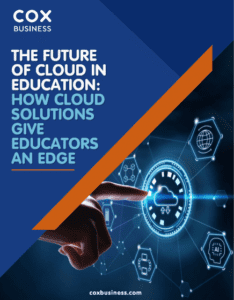
Educational institutions must navigate the demands of digital-first students while working with lean budgets. However, it’s not only about updating technologies in the classroom. Facilities must also extend services to virtual and hybrid learning environments. Therein lies the problem, figuring out how to stretch budgets to incorporate different learning models and maintain an IT staff to oversee various technologies.
Fortunately, the cloud gives educational institutions a way to dramatically increase their technology much faster than physical infrastructure typically can, both from a user and IT perspective, while maximizing budget spend. Below, we’ll explore the possibilities of the cloud for classrooms, campuses, and virtual environments, including foundational elements.
Facilitate Personalized Learning
A student-centric approach supports the ways students learn, communicate, and engage. Cloud technologies let learners revisit content and leverage different learning formats, from videos to interactive guides. This flexibility allows individual students to thrive, and it’s one reason why 82% of respondents to the HMH Educator Confidence Report “believe customized learning for every student will transform learning and teaching in the future.”
Indeed, 81% have realized the benefits of educational technology (EdTech), including “improved student engagement; differentiated, individualized instruction; and flexible access to instructional content.” Cloud-based access to recordings, transcripts, and additional resources empowers students to learn beyond the classroom while accommodating different learning styles.
Successful EdTech deployment depends on scalable cloud services supported by a stable internet and networking foundation. Private cloud investments often require upskilling and hiring IT workers, whereas Managed Cloud Services let you focus on modernizing your IT architecture and other student-centric improvements.
| Bring the benefits of Cox Business education IT solutions to your students, faculty, and staff. As a trusted partner in your community, we’re uniquely positioned to understand your needs and deliver tailored solutions that help improve educational experiences today and prepare for tomorrow’s future. Learn more |
Leverage Data to Improve Outcomes
Data has great potential for use in educational institutions. But housing this information is resource-intensive on already slim budgets. You’ll need to assess your infrastructure before equipping your facility with Internet of Things (IoT) devices or exploring the real-time feedback capabilities of edge computing.
Overcome this barrier by shifting some workloads to the cloud. You can take full advantage of existing technologies while experimenting with machine learning (ML) and artificial intelligence (AI) in your Learning Management System (LMS). We’ve seen institutions incorporate sensors into educational toys to gauge social dynamics and on the playground to capture safety data. In addition, edge computing supplies real-time information, allowing learning systems to intelligently adjust to a student’s learning style.
Educational institutions can work with managed cloud providers to tackle these goals without making significant hardware and IT investments. However, every technology objective must prioritize cybersecurity and student data privacy.
Protect Student Data and Networks
Protecting your network against attacks on your cloud infrastructure is critical. Ransomware attacks on the education sector continue to increase. Sophos’s new report, The State of Ransomware in Education, says the problem is exacerbated by “stretched IT teams battling to secure an outdated infrastructure with limited tools and resources.”
Of course, it doesn’t help that “72% of end-user devices in education environments are running an older version of the operating system,” according to Strikeforce Technologies. Leaders can reduce problems by switching to cloud-based tools that are automatically updated.
Attacks on third-party software providers impact your institution and students, meaning each vendor poses a risk. Your cloud and third-party solutions must have cybersecurity, data, and information policies designed to protect sensitive institutional information and constituents’ Personal Identifiable Information (PII).
To this end, it’s vital to work with your Internet Service Provider (ISP) and Managed Cloud Services Provider (MCSP) to strengthen your security measures and reduce threats. Partner with leaders who have an in-depth understanding of educational security and privacy requirements.
Meet Requirements for Virtual and Hybrid Learning Environments
Undoubtedly, digital and analog are complementary force multipliers. Cloud computing merges traditional and modern methods of learning and instruction. Therefore, updating your learning environment accelerates innovation in education and supports real-time collaboration in and out of the classroom.
As educators adopt virtual and hybrid learning environments, the demand for high-speed and high bandwidth Internet will increase. According to Accenture, “96% of students find a high-quality digital experience important to their satisfaction, an increase from 2017,” suggesting that the cloud is essential to student satisfaction and could increase enrollment rates for cutting-edge institutions.
However, 2.3 million students don’t have classroom connectivity, and 1,356 schools still need fiber. This challenges institutions to ensure their connectivity securely scales to meet the needs of students and faculty.
Future-Proof Educators and Students
A fair share of educators face knowledge barriers to implementing technology in the classroom. While many technology-hesitant teachers gained proficiency during the pandemic, challenges still exist. Cloud services enable students and educators to develop 21st-century skills required inside and outside the classroom.
Your technology partnerships do more than ensure reliable, secure connectivity. Managed service providers also work with your organization to develop deployment strategies and overcome skill gaps. Live training sessions and e-learning programs help staff update skillsets, identify classroom opportunities, and take advantage of hybrid modes of instruction.
Likewise, incorporating digital activities into on-campus and school events prepares students for the future of work — which as data shows, includes remote jobs and online onboarding and training sessions. Cloud-based digital tools improve future outcomes, with over half of respondents to a GLG survey saying, “EdTech helped them develop their students’ skills.”
Unlock New Creative Technology Strategies
Cloud technologies and modernizing infrastructure are key components of technology plans. Consultative technology partnerships enable a strategic approach to cloud solutions that fit existing infrastructure and future plans. Work with a Managed Service Provider that can assist with migration and security while providing ongoing support for cloud services.
| Bring the benefits of our education IT solutions to your students, faculty, and staff. Learn more |


